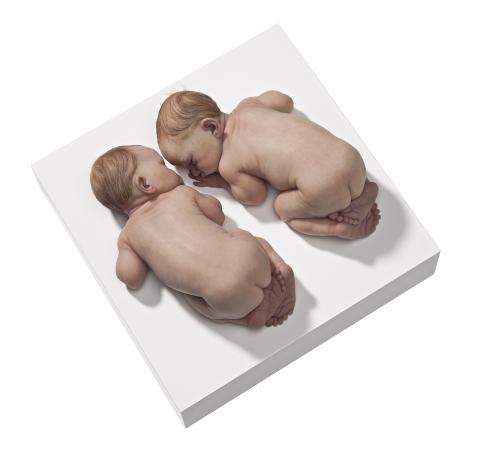UNTITLED, 2012 – 14
SAM JINKS
silicone, pigment, resin and human hair on a painted wooden base
36.0 x 36.0 x 18.0 cm
signed and dated on base: SAM JINKS / 2014
Sullivan + Strumpf, Sydney
Private collection, Sydney
Time Machine: Sam Jinks, Sullivan + Strumpf, Sydney, 16 October – 3 November 2012 (another example)
Art Stage Singapore: Sam Jinks, Sullivan + Strumpf, 23 – 27 January 2013 (another example)
In The Flesh, National Portrait Gallery, Canberra, 7 November 2014 – 9 March 2015 (another example)
These small, painstakingly mimetic sculpted twins exist in an intimate and fragile symbiosis, frozen in time and space. The jaw-dropping exactitude now expected of hyperrealist sculpture has only become technically achievable in the last ten years, facilitated by innovation in synthetic materials such as fibreglass, silicon and resin, an art truly of our time. Photorealism and hyperrealist sculpture are almost unparalleled in their ability to fascinate spectators, however this popularity is a double-edged sword. While it is remarkable to capture so quickly the viewer’s attention, it is a separate challenge to maintain this attention long enough to channel it toward pertinent conceptual foundations. Jinks is one of the few artists to achieve this feat. The conceptual foundation of his work is closely linked to his subject matter; he examines the human condition, and in particular the processes of growth and transformation as we navigate from womb to tomb. In addition to revelling in the minute details of tone and texture inherent in the human body, Jinks’ work encourages spectators to experience instinctive emotions: empathy, awe, fear. By subtly changing the scale of his sculptures, Jinks draws attention to our ultimate vulnerability and the transience of our physical bodies, while also providing a lens through which to avoid pure representational duplication.
Hyperrealist sculpture is an illusion, a trompe l’oeil so powerful that it causes us to question the reliability of our own powers of perception and our interaction with the physical environment. Jinks’ work is unsettling, a convincing tableau vivant of living beings, posed to evoke the milestones of human life. These scenes are inspired by the artist’s own personal experiences. 1 Through this verisimilitude, Jinks’ works can be linked to one of the most popular themes of art history, that of the demiurgic king Pygmalion and his animated sculpture Galatea. This myth of artistic creation, first penned by roman poet Ovid, finds its philosophical roots in Plato’s debate on the relationship between appearance and reality - that even the most convincing imitation of nature will always remain a facsimile. .
Australia has been a leading force in the second wave of hyperrealist sculpture since the late 1990s. Sam Jinks is the most recent addition to a small, tightly-knit group of acclaimed Australian artists working in similar media including Patricia Piccinini and Ron Mueck (who has since relocated to the United Kingdom), both of whom expanded on methods pioneered by the American artist Duane Hanson in the early 1970s.
Jinks was born in Bendigo, Victoria in 1973 and currently lives and works in Melbourne. Last year Jinks’ work, including these babies, featured prominently in the group exhibition, In the Flesh, at the National Portrait Gallery in Canberra. In 2013, Jinks was exhibited in a collateral event at the 55th Venice Biennale, following a successful solo show at Art Stage Singapore. His work features in public collections throughout Australia, such as the RMIT Collection, Melbourne; the McClelland Gallery and Sculpture Park; and the Shepparton Art Museum, where a survey exhibition of his work was held in 2012.
1. Craven, O., ‘Sam Jinks’, Artist Profile Magazine, no. 11, 2011, p. 59
LUCIE REEVES-SMITH
